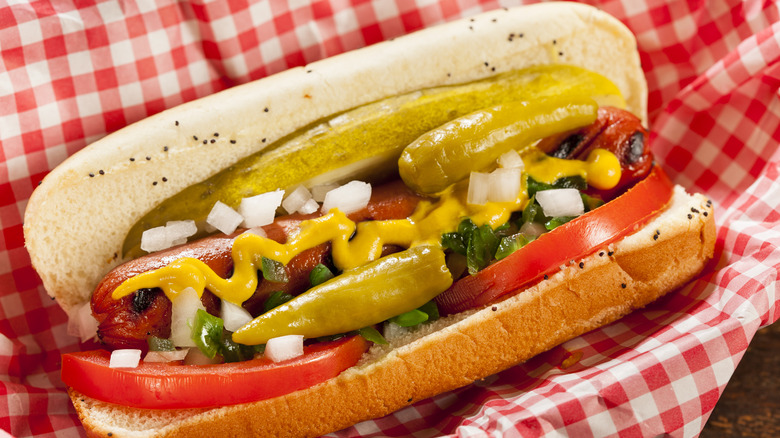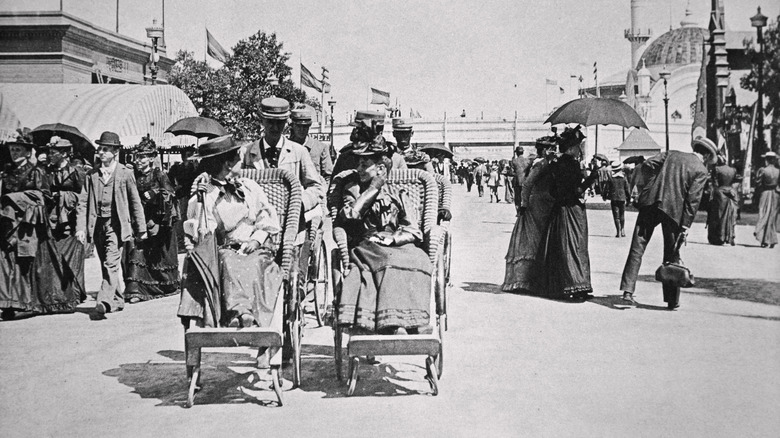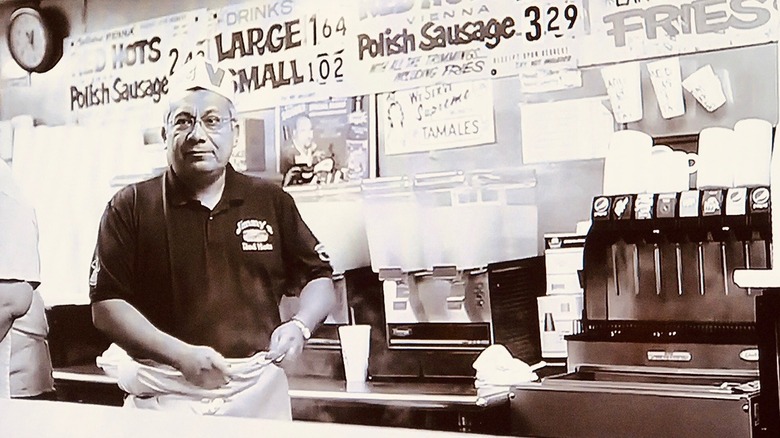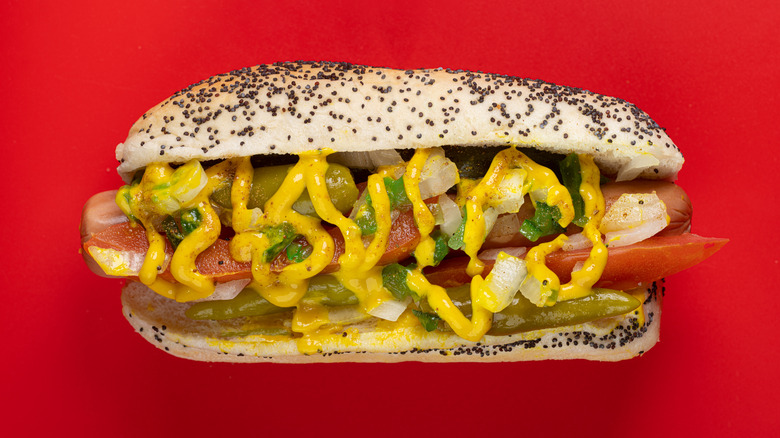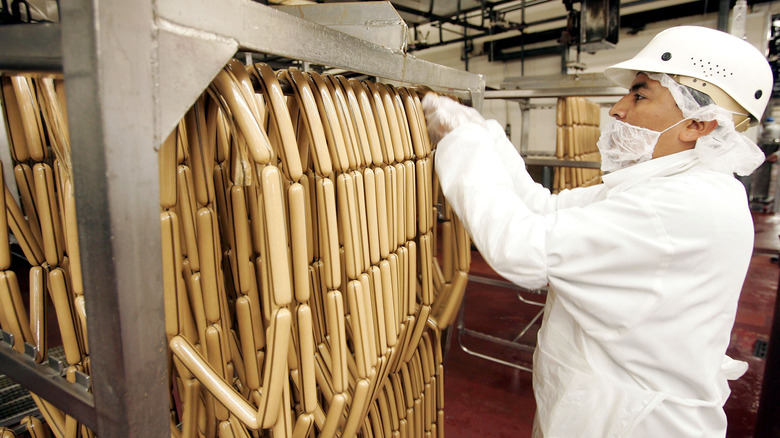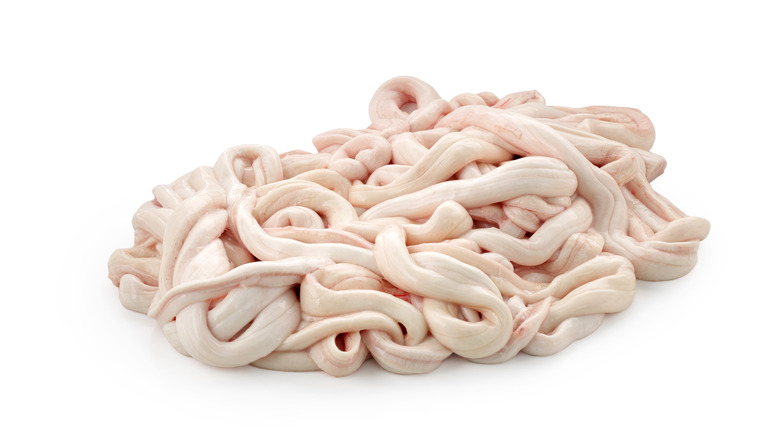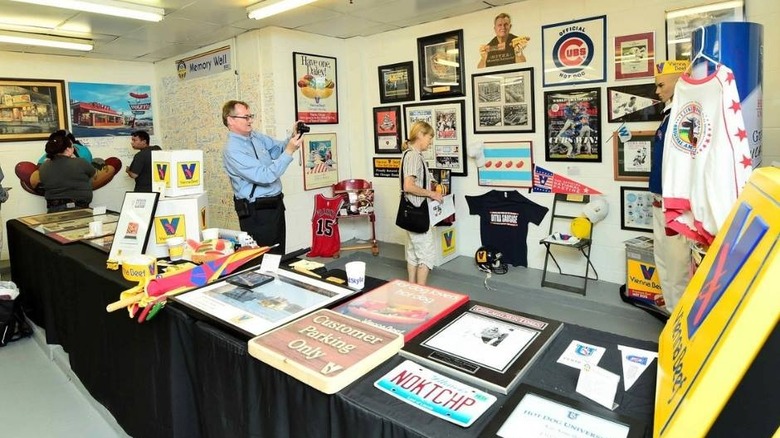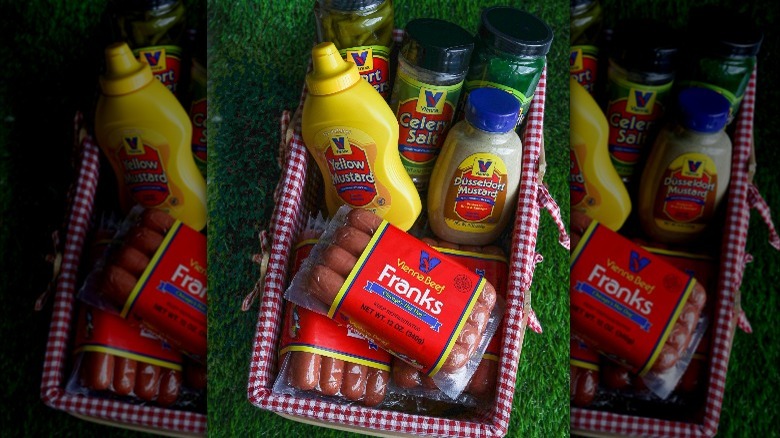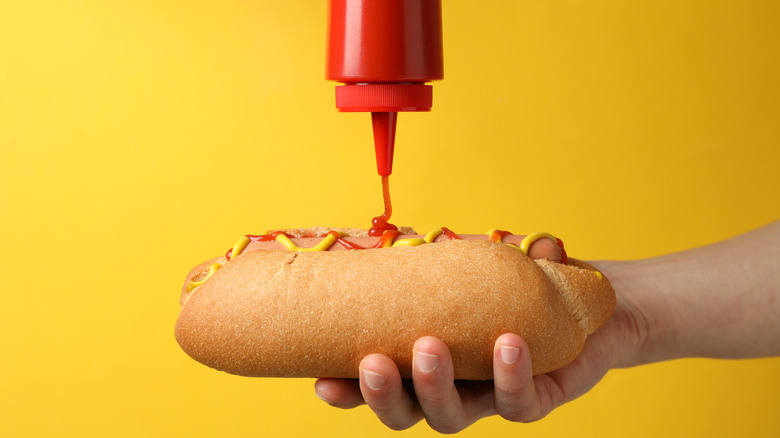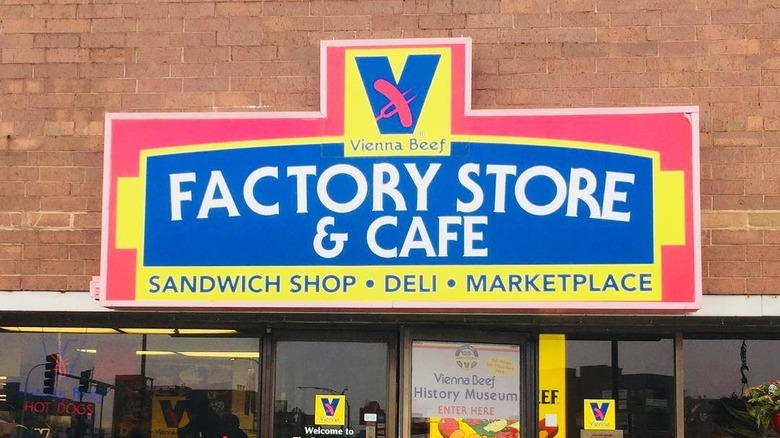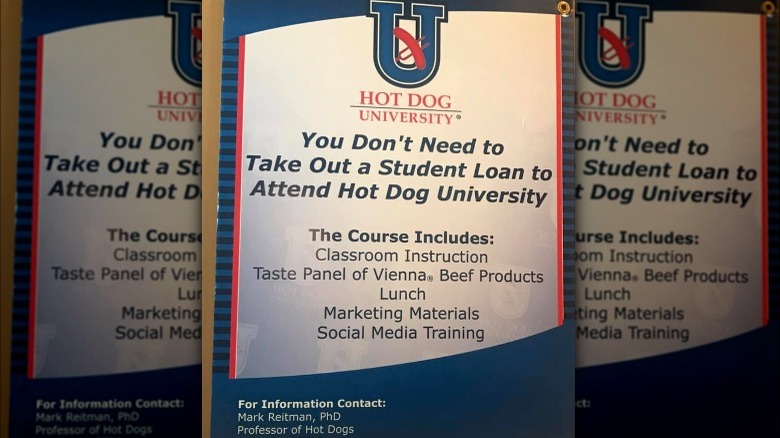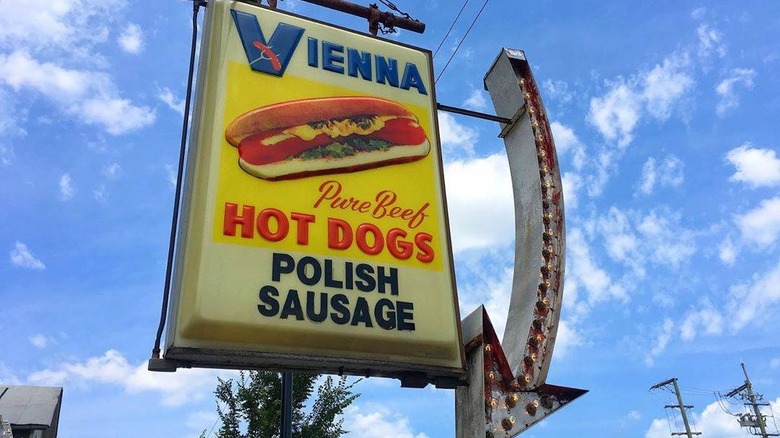The Untold Truth Of Vienna Beef Hot Dogs
Hot dogs. Frankfurters. Tube steaks. Weenies. Whatever you call them, there's no denying that these versatile sausages are an American standby. From backyard grills to fast-food joints to pots of baked beans, we find a way to sneak weenies into just about any setting here in the good old U.S.A. This country is also a tapestry of different regional hot dog styles, with iterations as diverse as the bacon-wrapped Sonoran dog and the cream cheese-slathered Seattle dog. The Chicago dog, with its abundant garnishes, is arguably the king of all the regional hot dog variations. Although the style is often defined by its toppings, no hot dog can really call itself a Chicago dog unless the frank is made by Vienna Beef.
While hot dogs don't have the most stellar reputation from a quality perspective, you don't have to worry about finding pig snouts our broken glass in you Vienna Beef franks. These hot dogs are still made the old-fashioned way, from cuts of beef you might actually recognize, like brisket (via Serious Eats). That meat is stuffed into a natural casing, then smoked with real hickory sawdust. All in all, Vienna produces an elevated tube steak, and they've been doing it for well over a century. If you want to learn more about Chicago's favorite hot dog, keep on reading.
It all started with the 1893 Chicago World's Fair
The 1893 Chicago World's Fair (or officially, the World's Columbian Exposition), is responsible for so many American food innovations that it's hard to keep track of all of them. Classic brands like Cracker Jack, Heinz, and Pabst Blue Ribbon beer all got their first big break from the event (via NPR). Vienna Beef hot dogs are another great American food that launched during that momentous event.
According to the company's official history, Vienna Beef hot dogs made their debut at the World's Fair when two Austro-Hungarian sausage makers, Emil Reichel and Samuel Ladany, sold their new wieners to attendees. Per Funding Universe, the name of the company was an allusion to Vienna, Austria, which was notable for making high-quality sausages. The hot dogs were such a smash hit that the pair were able to open their own store just a year later. Demand quickly grew beyond what one storefront could satisfy, so Vienna Beef started distributing its meats to Chicago-area restaurants and groceries by the turn of the century.
The Depression and World War II improved Vienna Beef's fortunes
While the Great Depression was a time of hardship and deprivation for many, it was a boon to Vienna Beef's bottom line. According to Funding Universe, since hot dogs were cheap, they became a preferred meal for money-conscious Chicagoans during the Depression. The Depression years coincided with an explosion in the number of hot dog stands in the city, a trend that the Vienna company actively promoted and encouraged. The company taught aspiring hot dog vendors the tricks of the trade, only asking that the budding entrepreneurs exclusively sell Vienna Beef hot dogs and adorn their stands with Vienna Beef-branded signage in exchange.
Hot dogs continued to grow in popularity during World War II and the post-war era, partly as a result of wartime rationing, and partly because they were convenient. A Vienna Beef Facebook post commemorates the legacy of Henry Davis, a salesman who is responsible for opening several hundred Vienna hot dog stands during this period. Per the company's website, Vienna Beef products began showing up in cities outside of Chicago during the post-war years as well.
Diverse immigrant communities created the modern Chicago dog
If Vienna Beef hot dogs are the ultimate dog (and it's not hard to find people who argue that they are), then the ultimate way to serve them is in the classic Chicago "dragged through the garden" style. A place called Fluky's came up with something very much like the modern Chicago-style hot dog in the 1930s. Fluky's called their iteration a "depression sandwich," and topped it with tomatoes, lettuce, mustard, pickles, relish, onions, and hot peppers. Swap out the lettuce for celery salt, and you have a Chicago dog exactly like any you'd get on the streets of Chicago today.
But where did all those toppings come from? According to Heinen's, Chicago's immigrant food traditions all combined to birth the city's famous hot dog. The mustard and pickles are German contributions, while the hot peppers and relish are somewhat similar to Italian giardiniera. The fresh vegetables may have been a Greek innovation. Add all that together, and you have a veritable melting pot sitting on top of a sausage, with the bun struggling to contain the mountain of salad inside of it.
They almost ruined the recipe when they changed factories
Per Vienna Beef's website, the company moved Chicago meat production to a new factory on the North Side of Chicago in 1972. Company Chairman Jim Bodman explained to This American Life that, unlike the rather chaotic and slapdash old Maxwell Street plant, the new location was a state-of-the-art, purpose-built facility. It should have been perfect for making hot dogs, but the sausages that came out of the new factory just weren't as good as the old ones had been. They lacked Vienna Beef's trademark bright red color and they didn't have the snap you would expect from an old-school natural-casing hot dog. The company brass was flummoxed by the issue, and though they tried their best, over a year after they moved into the new facility, they were still at a loss to explain the change.
Finally, they had a breakthrough: Some Vienna factory workers went out for a drink with a retired coworker named Irving. Irving explained that at the old plant, he carted the raw hot dogs through several warm rooms to get to the smokehouse where they were cooked. At the new factory, the raw sausages were kept ice-cold until they went into the smoker. It turned out that the hot dogs needed to be warmed up before smoking to get that classic Vienna snap and color. To rectify the issue, Vienna built a special warming room to replicate the quirks of their old factory.
Vienna Beef hot dogs are all-beef — except for one crucial ingredient
Vienna Beef franks are made from 100% domestic, American-raised beef (via Heinen's). Since most hot dogs, especially cheaper ones, are made from a blend of several meats, this fact makes Vienna sausages stand out from other franks. All-beef hot dogs have a more robust flavor that can stand up to the mountain of condiments that gets piled on a typical Chicago dog. Beef sausages come from a tradition of kosher butchery, as Jews can't eat pork. However, Vienna Beef's FAQ page clearly states that their products are not kosher. So what gives? The secret is in the casing.
Any Chicagoan will tell you that one of the things that makes a true Chicago-style hot dog different from other cities' tube steaks is that the frank snaps when you bite into it. That snappy texture is a product of using a natural casing, or in less polite language, animal intestines, to contain the sausage filling. Most modern hot dogs refrain from using this old-world technique, resulting in a less-satisfying, softer texture. Per the Vienna Beef FAQ page, the company uses either pig or sheep casings to make its franks, so while the insides are 100% beef, the outer layer is made out of another animal entirely.
There used to be a Vienna Beef museum
In 2018, Vienna Beef celebrated 125 years in the hot dog business by opening a museum inside its headquarters/factory building (via Chicago Magazine). The museum collected photographs, artifacts, and ephemera from the company's long history, giving hot dog fans a deeper understanding of their favorite food. In the museum, you could see a picture of the demolition of the company's old factory, a feat that was accomplished with a custom-made hot dog-shaped wrecking ball. Perhaps the strangest item on display was a hot dog keychain made out of a real mini-sausage covered in gold plating. The sausage was still intact several decades after it was made, though you wouldn't catch us trying to eat it.
Sadly, according to Block Club Chicago, the museum didn't survive Vienna Beef's move to a new headquarters in 2020. Where will all the hot dog history heads go to get their fix now? Maybe it's time for Nathan's Famous to think about building a museum.
Hot dogs are only a part of the company's portfolio
While Vienna Beef is most famous as a hot dog manufacturer, that's just the tip of the iceberg as far as their product line goes. In terms of tubular meats, the company also sells Polish sausages and bagel dogs. If you're a homesick Chicagoan looking to replicate your hometown hotdog in your own kitchen, Vienna Beef has you covered, as they sell mustard, giardiniera, pickled sport peppers, and most crucially, that inimitable radioactive-green pickle relish. If you're hankering for Chicago's other sandwich contribution to the world, Italian Beef, you're in luck, because they have that too, as well as several other kinds of deli meats.
As the company's CEO told the Chicago Tribune, they also have a booming soup and chili business that sells directly to restaurants, and they're a strong player in the corned beef market as well. They even own a bread bakery! The hot dogs may get all the glory, but Vienna Beef knows a lot more than just how the sausage gets made.
Don't put ketchup on them
In the world of Chicago hot dogs, one condiment is absolutely verboten: ketchup. While the rest of the country happily slathers their sausages with this red sugary goo, its use is the ultimate frank faux pas in the Windy City. Chicagoans take this so seriously that when the Chicago Tribune asked Vienna CEO Jim Bodman if he would put ketchup on a hot dog, he responded "Good Lord, no! You'll get me shot."
Most of you have probably eaten a hot dog with ketchup before. Some of you may even think that a hot dog needs ketchup to taste its best. So why do Chicagoans get so up in arms about this innocuous sauce? While regional snobbery undoubtedly plays a large part in Chicago's ketchup beef, there's also sound reasoning behind it. As Vienna Beef Senior Vice President of Marketing/Commerce Tom McGlade explained to Heinen's, "all of the condiments on a Chicago Style hot dog work together and don't fight each other. We've got spicy, we've got mild, we've got crunch, we've got soft and all of these things are going on in the same bite. Adding ketchup on there just masks the flavors."
They plan to stay in Chicago
Vienna VP Tom McGlade told Chicago Magazine that the company controls more than 90% of the Windy City's hot dog stands. That's quite an impressive stranglehold on the city's hot dog market, and it lends credence to CEO Jim Bodman's boast to the Chicago Tribune that the company "doesn't have any competition" for hot dogs in Chicago. In that town, hot dogs and Vienna Beef are basically synonymous, so it makes sense that the company wants to stay in the city where its most passionate fans are located.
That doesn't mean that staying in Chicago doesn't come with its own set of challenges, however. Later in that same Tribune interview, Bodman has some rather insulting things to say about doing business in the state of Illinois. He says that his home state is broke, and accuses Illinois of sending excessive health inspectors to the factory to try to earn extra money by catching code violations and imposing fines. We can't really confirm the veracity of those allegations, but the good news is that the brand plans to stay in Chicago for the foreseeable future despite its quibbles with its home state!
There's a Vienna Hot Dog University
Remember how we mentioned that Vienna Beef encouraged the opening of new hot dog stands during the Depression by training would-be sausage slingers and giving them merch? Well, it turns out they're still doing the same thing today. These days, they call their training program Hot Dog University. The course is taught by Mark Reitman, PHD (which stands for Professor of Hot Dogs, of course). A cool $699 (marked down to $299 for a pandemic-appropriate e-course) earns you everything you need to know about running a hot dog stand.
According to a writer at Serious Eats who took the course, the two-day experience gives you a lot of bang for your buck. On the first day, you learn the ins and outs of success in the street cart business, including strategies for choosing the perfect stretch of sidewalk and ways to entice customers to your stand. On the second day, you get to peel back the curtain at the Vienna Beef factory and see how the dogs are made. After the tour, you put your new knowledge to the test by running a hot dog stand on Vienna's campus. The best part is that after the lesson, you get $350 in vouchers for free Vienna Beef products and another $350 worth of swag and signs to help start your new hot dog empire.
One woman visited 367 Vienna Beef hot dog stands in 60 days
In August of 2021, Vienna Beef posed a challenge to Chicago residents: How many Vienna Beef hot dog stands can they eat at in 60 days? Thus began the Vienna Beef Hot Dog Stand Challenge, a two-month marathon in which people in the greater Chicagoland area, including bits of Wisconsin and Indiana, vied to visit the greatest number of stands in a two-month period (via WGN9).
The winner, Stephanie Esposito, ate at an eye-watering 367 hot dog joints before the challenge was over. By our math, that's over six hot dogs a day! Although we're sure victory felt sweet, for Esposito, the challenge was more than just a mere competition — the real magic was the journey along the way. As she told WGN9, "It was an incredible experience getting to visit parts of the region and meet people that I would never have had the chance to if it wasn't for Vienna Beef hosting this challenge."
